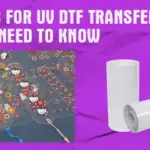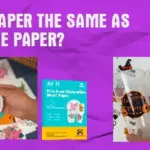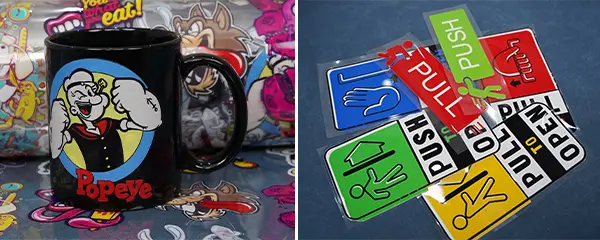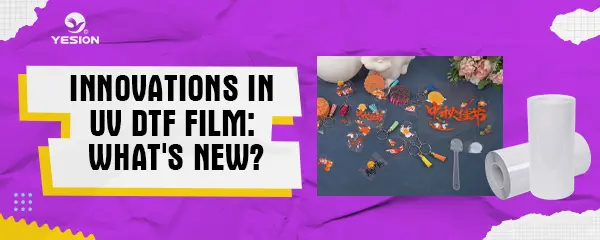
Materials for UV DTF Transfers: What You Need to Know
2024-11-05
Is decal paper the same as waterslide paper?
2024-11-13The world of UV DTF (Direct to Film) printing is constantly evolving, with advancements that continue to push the boundaries of what’s possible in custom printing. UV DTF film has transformed how we apply vibrant, durable designs to a wide variety of surfaces, such as glass, metal, ceramics, and plastic. As new technologies emerge, UV DTF films have become even more versatile, efficient, and high-quality. In this article, we’ll explore the latest innovations in UV DTF film and how they can elevate your printing projects to the next level.
Key Innovations in UV DTF Film
1. Enhanced Adhesion Technology
One of the latest breakthroughs in UV DTF film is enhanced adhesion technology. This advancement addresses common adhesion issues on challenging surfaces, such as rough or curved materials, making it easier to create secure, long-lasting designs on a broader range of items.
Improved Adhesion Strength: New adhesives can bond effectively to tricky surfaces like glass or metal, ensuring a seamless and durable transfer.
Versatility Across Surfaces: With this innovation, UV DTF films now work well on materials like leather, wood, and even fabrics.
Reduced Peeling and Cracking: Enhanced adhesion also reduces the likelihood of peeling or cracking, even with frequent use or cleaning.
2. High-definition Color Quality
Color vibrancy has always been a strength of UV DTF printing, and recent improvements have taken it a step further. High-definition color technology enhances color accuracy, brightness, and clarity, resulting in designs that are sharper and more impactful.
Better Color Reproduction: Advanced color technologies improve consistency and accuracy, making it possible to match exact colors for brand logos or detailed artwork.
Vibrant, Fade-Resistant Colors: These new UV DTF films use inks and curing processes that resist fading, even with extended UV exposure or frequent cleaning.
Specialty Inks: Metallic, white, and transparent inks are now more widely available, allowing for unique effects and creative designs.
3. Improved Durability and Scratch Resistance
Durability has always been a hallmark of UV DTF printing, and new innovations have focused on making films even more scratch and abrasion-resistant.
Advanced Protective Coatings: Recent UV DTF films include special coatings that provide added scratch and abrasion resistance, helping designs stay pristine over time.
Longer Lifespan: These coatings enhance UV protection, making prints less likely to fade or degrade when exposed to sunlight.
Water and Chemical Resistance: New formulations are highly resistant to water, oils, and household chemicals, making them ideal for items that see heavy use.
4. Flexible and Stretchable Films
Traditionally, UV DTF films have been somewhat rigid, limiting their use on certain flexible or irregular surfaces. New stretchable UV DTF films have changed that, enabling the transfer of designs onto surfaces that require flexibility.
Perfect for Curved or Textured Surfaces: These films are ideal for products like drinkware, helmets, and other rounded surfaces.
Enhanced Flexibility Without Cracking: The improved flexibility prevents cracking or distortion of the design, even when applied to materials that bend or flex.
Easy Application: Stretchable films conform more easily to difficult surfaces, making the application process smoother and less time-consuming.
5. Environmentally Friendly Options
As the industry moves towards eco-friendly practices, new UV DTF films are being developed with sustainability in mind. Many manufacturers are now offering options made with recyclable or biodegradable materials.
Reduced Environmental Impact: These eco-friendly films minimize harmful chemicals and promote responsible sourcing.
VOC-Free Inks: Some innovations include inks with zero volatile organic compounds (VOCs), ensuring a safer work environment.
Recyclable Film Options: Recyclable films are designed to minimize waste and make disposal easier, appealing to eco-conscious businesses and consumers alike.
6. Enhanced UV Curing Speeds
One of the more recent advancements is in UV curing speeds. Faster curing times allow for increased productivity and a more streamlined process, especially important for high-volume printing jobs.
Reduced Production Time: Faster curing minimizes wait times, allowing more transfers to be completed in a shorter period.
Energy Efficiency: Improved UV curing technology requires less energy, making the process more eco-friendly and cost-effective.
Consistent Curing Quality: Innovations ensure uniform curing, preventing over- or under-curing, which can compromise print quality and durability.
7. Heat-resistant Films
For items that will be exposed to high temperatures—such as those used in kitchens or under direct sunlight—heat-resistant UV DTF films provide added protection.
Increased Temperature Tolerance: Heat-resistant films can withstand higher temperatures without warping, peeling, or fading.
Perfect for Outdoor and Kitchen Use: These films are ideal for items like mugs, tumblers, and outdoor signage that may face high heat.
Preserves Print Integrity: Heat-resistant films help ensure that the design remains intact and clear even under extreme conditions.
Choosing the Right UV DTF Film for Your Project
With these innovations in mind, selecting the best UV DTF film for your needs is easier than ever. Here are some considerations:
Consider the Surface Type
Different surfaces benefit from different film types:
Smooth Surfaces (Glass, Metal): Look for films with enhanced adhesion and high-definition color.
Flexible Surfaces (Curved or Textured): Choose stretchable films that conform to the shape.
High-Use Items (Mugs, Water Bottles): Opt for scratch-resistant and heat-resistant films to ensure durability.

UV DTF Film for Projects
Assess Durability Needs
For items that will see frequent use, opt for UV DTF films with advanced protective coatings to guard against scratches, chemicals, and water damage.
Go Green When Possible
If sustainability is a priority, look for eco-friendly films and VOC-free inks that align with your environmental values.
From enhanced adhesion and color vibrancy to eco-friendly materials and heat-resistant options, the latest innovations in UV DTF film make it possible to tackle almost any printing project. By understanding the new technologies available, you can choose the perfect film for your project and create stunning, durable prints that stand the test of time.
Related:
Top 10 Benefits of UV DTF Film for Your Printing Needs
Best UV DTF Film Suppliers You Need to Know
UV DTF Film Cost Breakdown: Is It Worth It?

